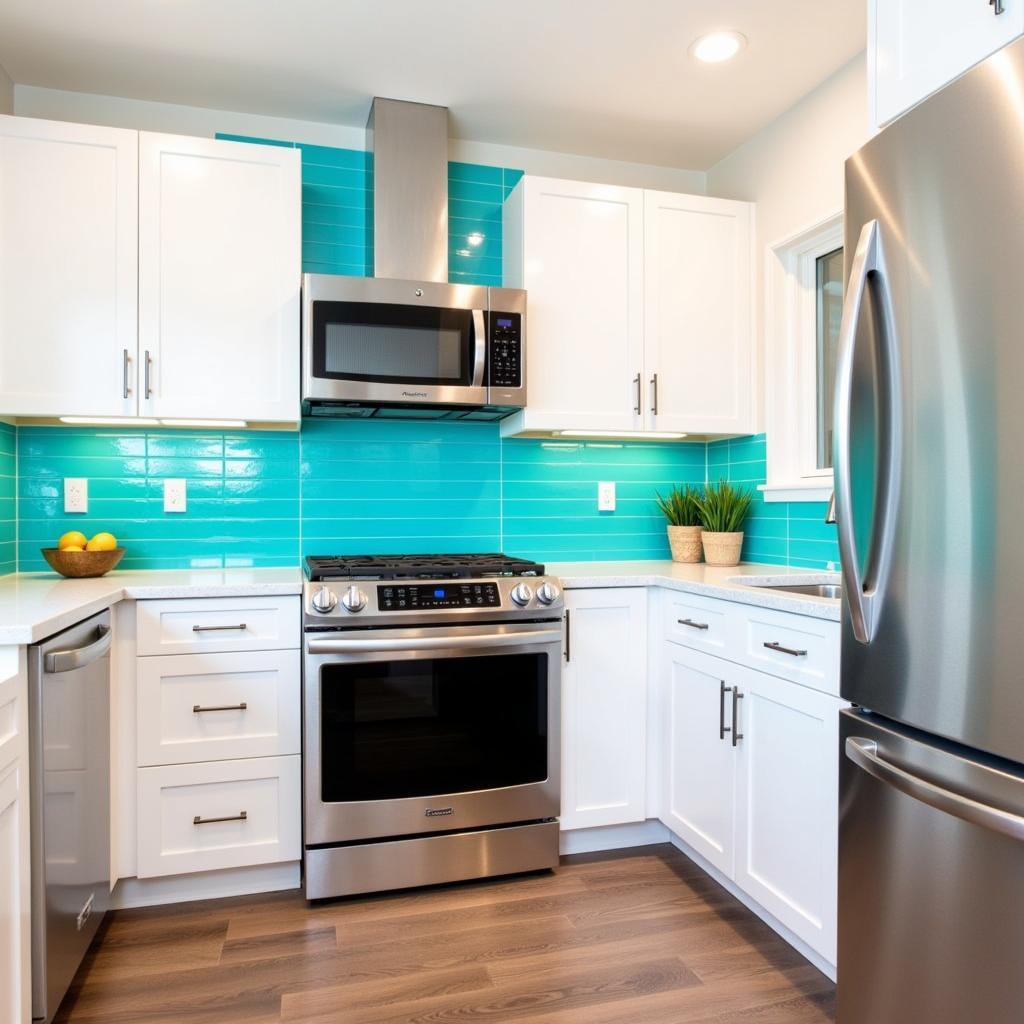Turquoise, a captivating blend of blue and green, evokes images of tranquil oceans and vibrant gemstones. But what colors match with turquoise to create stunning combinations in your home, wardrobe, or creative projects? This comprehensive guide will explore the diverse palette of colors that harmonize beautifully with turquoise, allowing you to unlock its full design potential. After reading this, you’ll be ready to confidently incorporate this mesmerizing hue into any space. See which colors are best for braces, for more color inspiration.
Unveiling the Versatility of Turquoise: A Color Chameleon
Turquoise is a remarkably versatile color, capable of playing both leading and supporting roles in a color scheme. Its complex undertones allow it to pair well with a surprising range of hues, from warm earth tones to cool, crisp whites. Whether you’re seeking a vibrant, energetic combination or a serene, calming atmosphere, turquoise offers a wealth of possibilities.
Complementary Colors for Turquoise: A Dynamic Duo
One of the most effective ways to use turquoise is to pair it with its complementary color, which sits directly opposite it on the color wheel. For turquoise, this is a warm coral or reddish-orange. This pairing creates a high-contrast, visually striking combination that is perfect for making a bold statement. Imagine a turquoise sofa with coral throw pillows, or a turquoise dress accented with coral jewelry. This vibrant duo is sure to turn heads.
Analogous Harmony: Creating a Serene Flow
For a more subtle and harmonious look, consider pairing turquoise with analogous colors, which are adjacent to it on the color wheel. These include shades of green and blue. A combination of teal, turquoise, and aqua creates a calming, ocean-inspired palette, perfect for bedrooms or bathrooms. Adding a touch of emerald green can create a richer, more sophisticated feel.
Neutrals that Enhance Turquoise: A Balancing Act
Neutral colors such as white, gray, and beige provide a perfect backdrop for turquoise, allowing its vibrancy to shine. Crisp white creates a fresh, airy feel, while soft gray adds a touch of sophistication. Beige and other warm neutrals bring a sense of earthiness and grounding to the palette.
Metallic Magic: Elevating Turquoise with Gold and Silver
Metallic accents like gold and silver can add a touch of glamour and elegance to turquoise color schemes. Gold complements the warm undertones of turquoise, creating a luxurious and opulent feel. Silver, on the other hand, enhances the cool, refreshing aspects of turquoise, resulting in a more modern and sleek aesthetic. Consider incorporating gold or silver accessories, lighting fixtures, or furniture details to elevate your turquoise-infused space. Curious about other color combinations? Check out what colors match with coral for further inspiration.
Turquoise in Different Settings: Adapting to Your Space
Turquoise in the Living Room: Creating a Welcoming Atmosphere
In the living room, turquoise can be used to create a vibrant and inviting atmosphere. Use it as an accent wall color, paired with neutral furniture and colorful accessories. Or, opt for turquoise upholstery on sofas and armchairs for a bolder statement.
Turquoise in the Bedroom: A Tranquil Retreat
In the bedroom, softer shades of turquoise can promote relaxation and create a peaceful sanctuary. Consider pairing pale turquoise walls with white bedding and natural wood accents for a calming, spa-like feel. If you are considering what color matches gray shorts for a casual day out, turquoise may be a good option!
Turquoise in the Kitchen: A Burst of Energy
Turquoise can add a pop of color and energy to the kitchen. Use it on cabinets, backsplashes, or even appliances to create a cheerful and inviting space.
 Turquoise Kitchen with White Cabinets
Turquoise Kitchen with White Cabinets
Expert Insights: Harnessing the Power of Turquoise
“Turquoise is a truly transformative color,” says renowned interior designer, Amelia Hayes. “Its ability to evoke both tranquility and vibrancy makes it a powerful tool for creating spaces that are both beautiful and emotionally resonant.”
Color psychologist, Dr. David Chen, adds, “Turquoise has been shown to have a calming effect on the mind, making it an ideal choice for spaces where relaxation and focus are desired.”
Conclusion: Embracing the Beauty of Turquoise
From vibrant accents to serene backdrops, turquoise offers a diverse range of design possibilities. By understanding the colors that match with turquoise and applying the principles of color harmony, you can create spaces that reflect your personal style and enhance your everyday life. What are you waiting for? Embrace the beauty of turquoise and transform your world with color. Find out more about color combinations by exploring what colors match with green clothing.
FAQ: Your Turquoise Questions Answered
- What is the complementary color of turquoise? Coral or reddish-orange.
- What are some analogous colors for turquoise? Shades of green and blue, such as teal, aqua, and emerald green.
- What neutrals work well with turquoise? White, gray, and beige.
- How can I use turquoise in my living room? As an accent wall color, upholstery, or in accessories.
- Is turquoise a good color for bedrooms? Yes, softer shades of turquoise can promote relaxation.
- What metals complement turquoise? Both gold and silver work beautifully with turquoise.
- Where can I find inspiration for turquoise color palettes? Online resources, design magazines, and nature.
Need more help with choosing the right colors?
Check out our articles on what 2 paint colors make intel blue or what colors are best for braces for more specific color combination advice.
For personalized color consultations and expert advice on paint selection and application, contact us at Color Box Hanoi:
Phone: 0373298888
Email: [email protected]
Address: 86 Cau Giay, Hanoi.
Our team of color specialists is available 24/7 to assist you with all your color needs.

